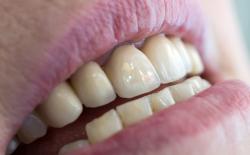Why do you need crown lengthening?
The crown lengthening procedure might be needed for several reasons. There are the most common ones:
1. To fix your teeth
If you do not have enough tooth to support a restoration/filling or a dental crown, you need a crown lengthening.
These are the most common cases:
- When your tooth fractures at the gum line
- When your crown detaches from your tooth, and there is a decay underneath
- You have deep cavities below your gums
In the cases mentioned above, your dentist needs to prepare your tooth so that it can hold your crown. Experts say you should have at least 3 mm of the tooth between your bone crest (bone lining of your tooth) and the margin of an artificial dental prosthesis/crown.
2. To enrich your smile
Your gums cover some of your teeth, and they are usually not visible when you smile.
However, for some people, a lot of gum cover their teeth, especially their upper teeth, and this is visible when they smile. Dentists call it a gummy smile. You can correct your gummy smile with crown lengthening, you can also correct uneven gums.
A few examples when crown lengthening is required. Duration: 2:41.
How does a crown lengthening procedure look like?
Periodontists (gum specialists) are the experts of crown lengthening. During the procedure they will have a look at your medical tests, X-rays, and conduct an oral examination to assess the following:
- The anatomy of the tooth which will undergo crown lengthening.
- The type of tooth, its roots, shape of roots, and the position of their furcation. Few teeth such as molars have multiple roots. Furcation is the point where the root bifurcates into more roots.
- The anatomy of soft tissues around, including the attachment of your facial muscles.
- The width of your gingiva.
- Interdental bone width.
- The quantity and quality of bone present in between your teeth.
In case you have a fracture or a dislodged filling, your dentist will give you a temporary crown.
The temporary crown makes the process easier for your periodontist as he/she will know exactly how much to lengthen.
Most of the times, you need a professional tooth cleaning one week before the surgery, to minimize the chances of post-surgery infections.
If you need a root canal treatment (RCT), it’s done before the surgery. RCT is a procedure wherein your dentist cleans the decay which has spread deep to the pulp of your tooth and seals it with a suitable material.
The time taken for the whole procedure depends on the number of teeth which need the crown lengthening.
However, even if you have to lengthen a single crown, you also need to lengthen the neighboring crowns, especially if it’s your front tooth so that the change looks gradual/natural.
If your dentist needs to remove only the gum tissue, the procedure is faster than removing both the bone and the soft tissue.
If you have a supporting medical history (no high blood sugar levels etc.), you will receive an appointment for the surgery.
Your dentist does your crown lengthening, and it may take three months to heal.
These are the steps of the procedure:
- At the beginning of the treatment, you receive local anesthesia.
- Once the anesthesia starts working, your dentist places cuts which separate your gums from your tooth. The extent of separation depends on the amount of tooth that you need to expose.
- In most cases, your dentist needs to remove some bone around your roots. However, sometimes, your dentist needs to expose a little more of your roots in order to make sure your crowns are firmly seated. Your dentist needs to pay special attention to the gingival level as well as the interdental papilla/gingiva in between your front teeth.
- After this, your dentist washes your exposed tooth with saline.
- Your dentist stitches your gums. You may also receive a bandage which helps your gums heal faster.
- Your dentist glues temporary crowns and prescribes a mouth wash and pain reliever medicines.
After the procedure
- You need to follow a soft diet.
- Apply ice on your face, in the area where you had the gum surgery. It will reduce bleeding and swelling.
- Brush your teeth but avoid your gums. You can clear the food near your gums by using a toothpick or using a water irrigator.
After 7 to 10 days, visit your dentist. If your gums have healed well, your dentist removes the stitches.
Visit your dentist again after 4 to 6 weeks for a follow-up visit. Your dentist makes sure your gums have healed over a period of three months and then proceeds with making a crown.
Since your gums shrink after they heal. If you do not wait long enough, the edges of your crown start showing up when your gingiva shrinks.
An overview of the crown lengthening procedure. Duration: 2:39.
How much does a crown lengthening cost?
The usual cost of crown lengthening is around $1,000-$2,000 in the US, for one tooth. Costs vary from case to case. You might get a discount if you need lengthening for multiple teeth.
Depending on your location, prices might be somewhat lower/higher.
Besides the usual things, like practice location, dentist experience, etc., there are a number of factors specific to crown lengthening that determines the price:
- the amount of gum to be removed
- if some of your bone needs to be removed, that will increase the price
- number of teeth that need lengthening (even if you need crown lengthening for 1 tooth, the adjacent tooth might also be impacted)
- any additional treatment you might need (root canals and dental crowns or fillings are the most common)
- you'll probably need a dental cleaning before the procedure, this usually adds $50-$200 to the final sum
Need a local dentist?
Call your periodontist if
- Your bleeding doesn’t stop
- Your pain reliever medicine isn’t working
- Your bandage is loose or falls off
- You notice excessive swelling or feel a discharge from the operated area
- You feel the wound may be infected
- You feel tender lumps / enlarged lymph nodes in your neck or your lower jaw
Risks associated with crown lengthening
The procedure may carry few risks such as:
Sensitivity
You may feel sensitivity in your teeth, especially with hot and cold. It will disappear with time, especially after you have a well-designed crown in place.
The tooth that has undergone surgery may look longer than the other teeth. However, if you have lengthened the adjacent teeth, it will look natural.
Loose tooth
A major challenge with the prepared tooth is that it might become loose due to removing excess bone, and may fall off in the future. When it does, it will be difficult to replace that tooth with an implant.
After a crown lengthening procedure, once your gingiva is healed, your dentist prepares your tooth again, and you will receive a new crown. Meet your dentist every six months, and more often if you feel any issues.
You might also be interested in:
Dental Crowns Cost
The price of a dental crown depends on many factors. Read our article to find out more about what affects the cost of a dental crown.
Dental Crown Pain
Secondary caries, infection, and loose crowns are some of the most common reasons for dental crown pain.
E-max Crowns
E-max crowns are also very popular. Just like zirconia crowns, they look great, are durable, and not cheap...


